A Kamikaze Attack on New Mexico, Fifth Fleet Flag: A Photo Essay
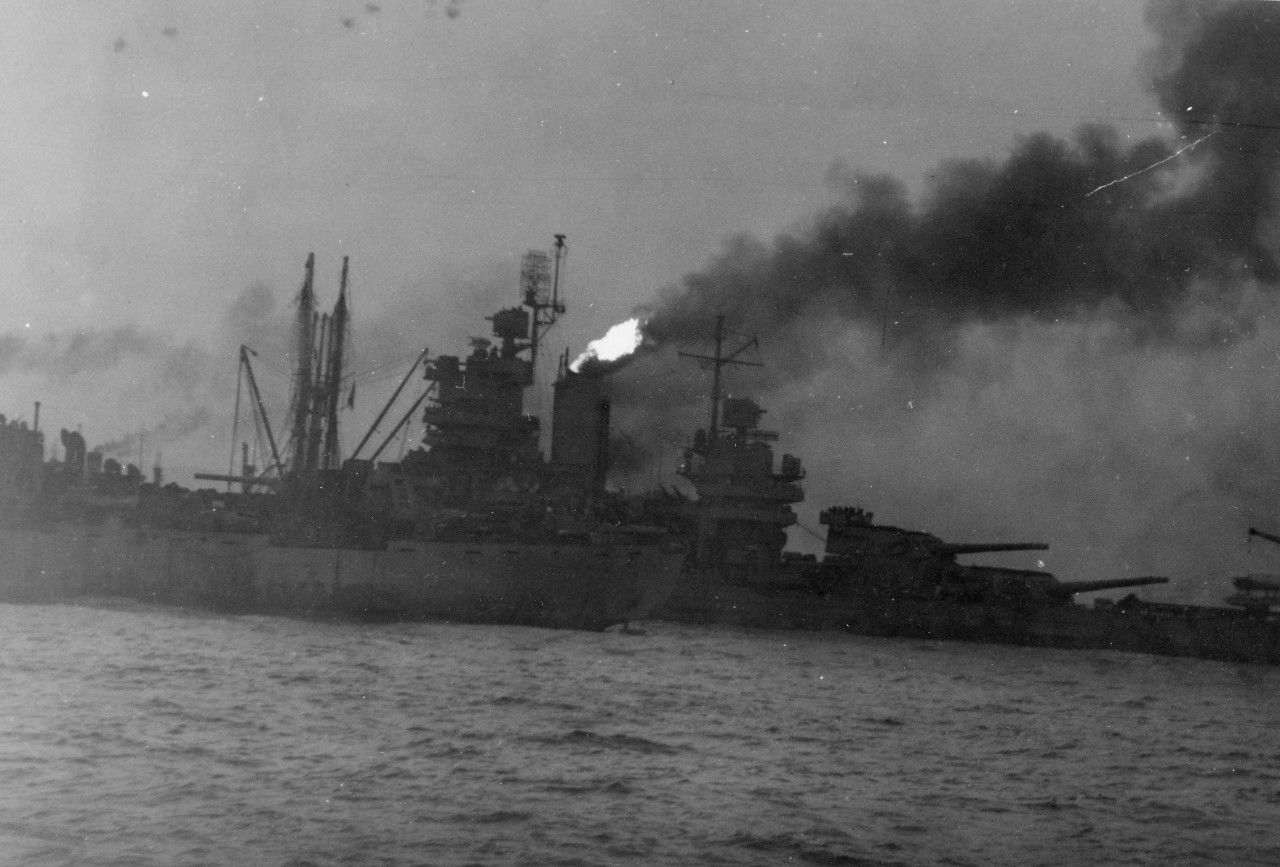
New Mexico (BB-40) immediately after a kamikaze crashed into stack, 12 May 1945. The photograph was taken from Wichita (CA-45). (80-G-328653, NARA II, College Park, Md.)
New Mexico (BB-40) approached her night anchorage at Hagushi off Okinawa the evening of 12 May 1945 after just completing a replenishment of provisions and ammunition at Kerama Retto. At 1856, Shubrick (DD-639), a destroyer on radar picket reported an enemy plane with a trailing friendly approaching the vicinity of the Fifth Fleet flagship 35 miles away. Now on alert, New Mexico turned to its own search radar and identified the same targets 21 miles away at 1900. Visual contact of the two planes was made at 1905 and the sky lookouts shortly after sighted four planes moving in a loose formation across their ship’s stern. Both of New Mexico’s Mk. 33 directors were trained on the port quarter at 1906 and General Quarters sounded minutes later—the forward director identified two friendlies and the after two enemies. The two Japanese planes (a “Frank” Ki-84 and “George II” N1K-J) crossed astern. The “George II” made its run, passing up the starboard side and turning towards the bow of its target. Four of New Mexico’s starboard five-inch guns, along with six 40mm and twenty-two 20mm guns, opened up on the target as it began its glide and strafing fire. One five-inch shell fortunately burst underneath the target causing it to lift, catch fire, and splash into the sea on the ship’s port quarter after it caused only minimal damage with its strafing.
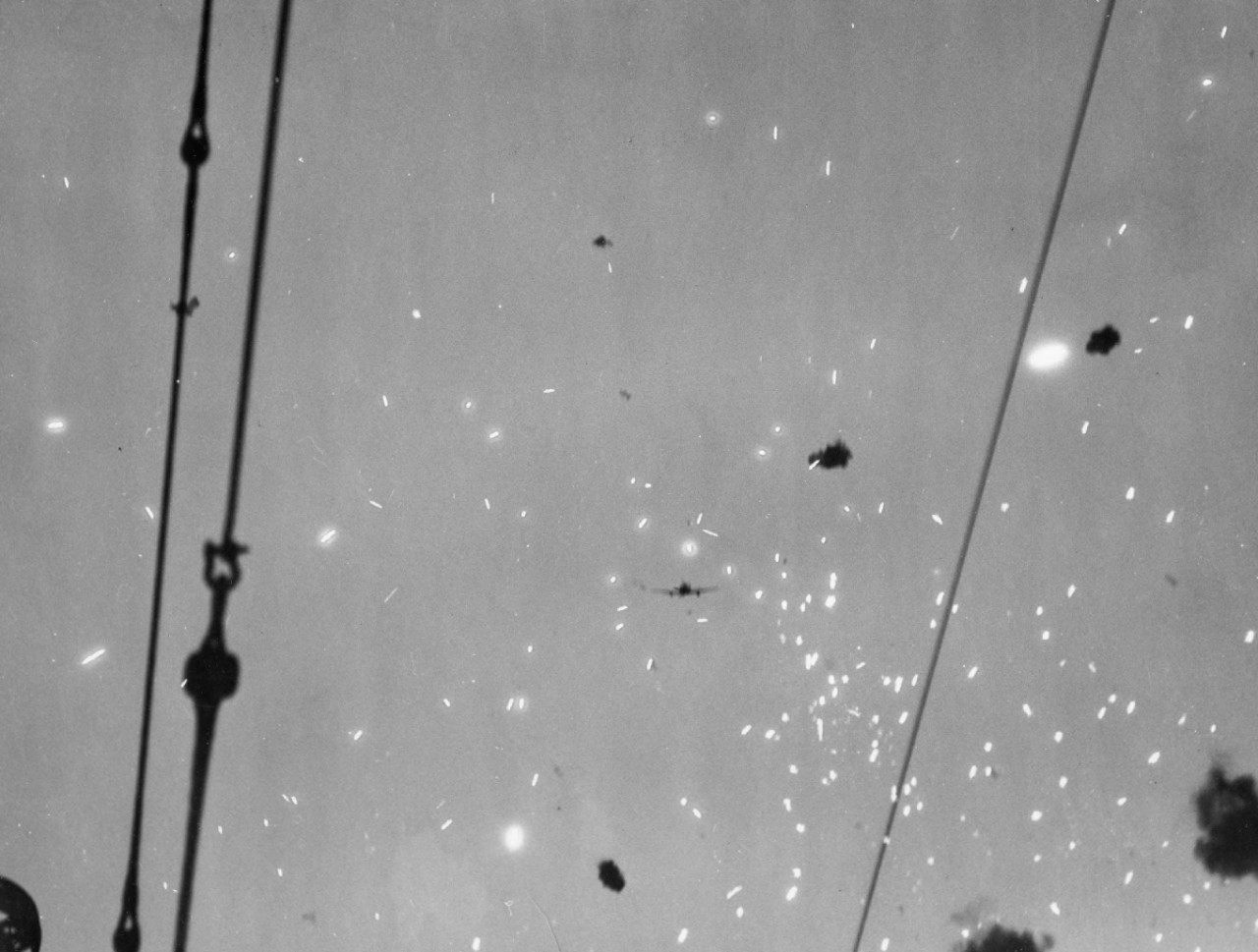
A.A. fire from New Mexico (BB-40) as the first kamikaze, a “George II” begins its dive on 12 May 1945. A five-inch shell burst underneath of it during descent and caused it to narrowly miss. (80-G-326638, NARA II, College Park, Md.)
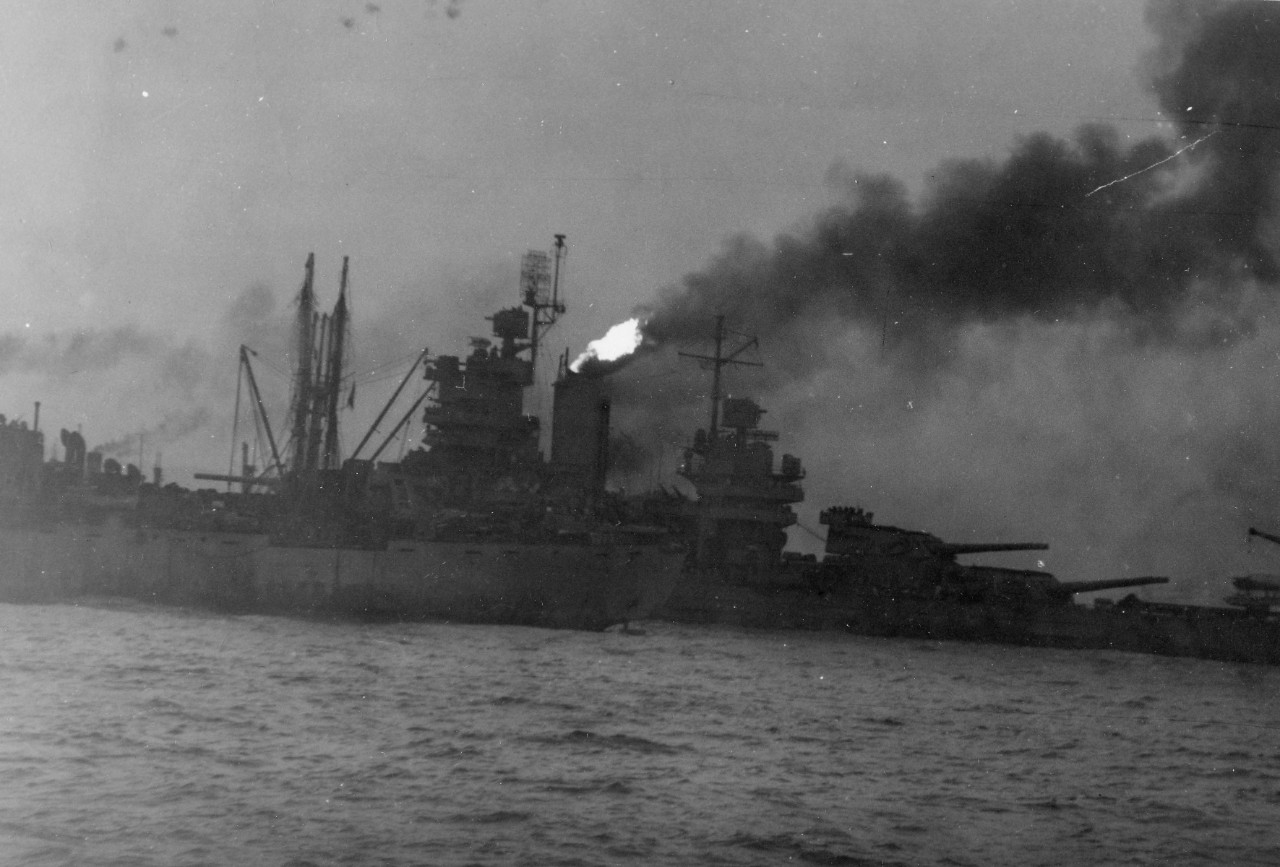
The stack of New Mexico (BB-40) seen burning like a blowtorch after the initial explosion. This helped contain the damage as the stack’s uptake drew much of the fire upward. The photograph was taken from Wichita (CA-45). (80-G-328654, NARA II, College Park, Md.)
The pilot of the “Frank” capitalized on the diversion caused by his wingman. As the first plane dove and drew fire, the second pilot, carrying a 500 lb. bomb, made a wide orbit and initiated his run. With the gun directors unable to swing back to the second target in the short amount of time that had elapsed, the only fire able to be brought on the second plane came from the crew manning three 40mm and fifteen 20mm mounts. Despite making several hits on the bogey, plane number two crashed into the ship’s gun deck on the starboard 20mm tub and smashed into the forward stack at 1912. A.A. ammunition fell through the hole created by the plane and tumbled down into the boilers causing a massive explosion that knocked three of New Mexico’s four boilers out of commission. Witnesses reported that the “top of the stack looked like a blow torch.” This was a fortuitous, as the smoke stack drew the force of the explosion upward and reduced the intensity of the fire on the gun deck level.[1] The damage was quickly controlled, but the six minutes between visual contact and crashing came at a high cost. New Mexico reported afterward that the attack was “well-coordinated” and “delivered by what appeared to be skillful and intelligent pilots.” It was notable to the crew the pilot who crashed into the ship was identified as a sergeant (he was recovered still strapped in his seat along with his plane’s engine wedged in the stack).[2]
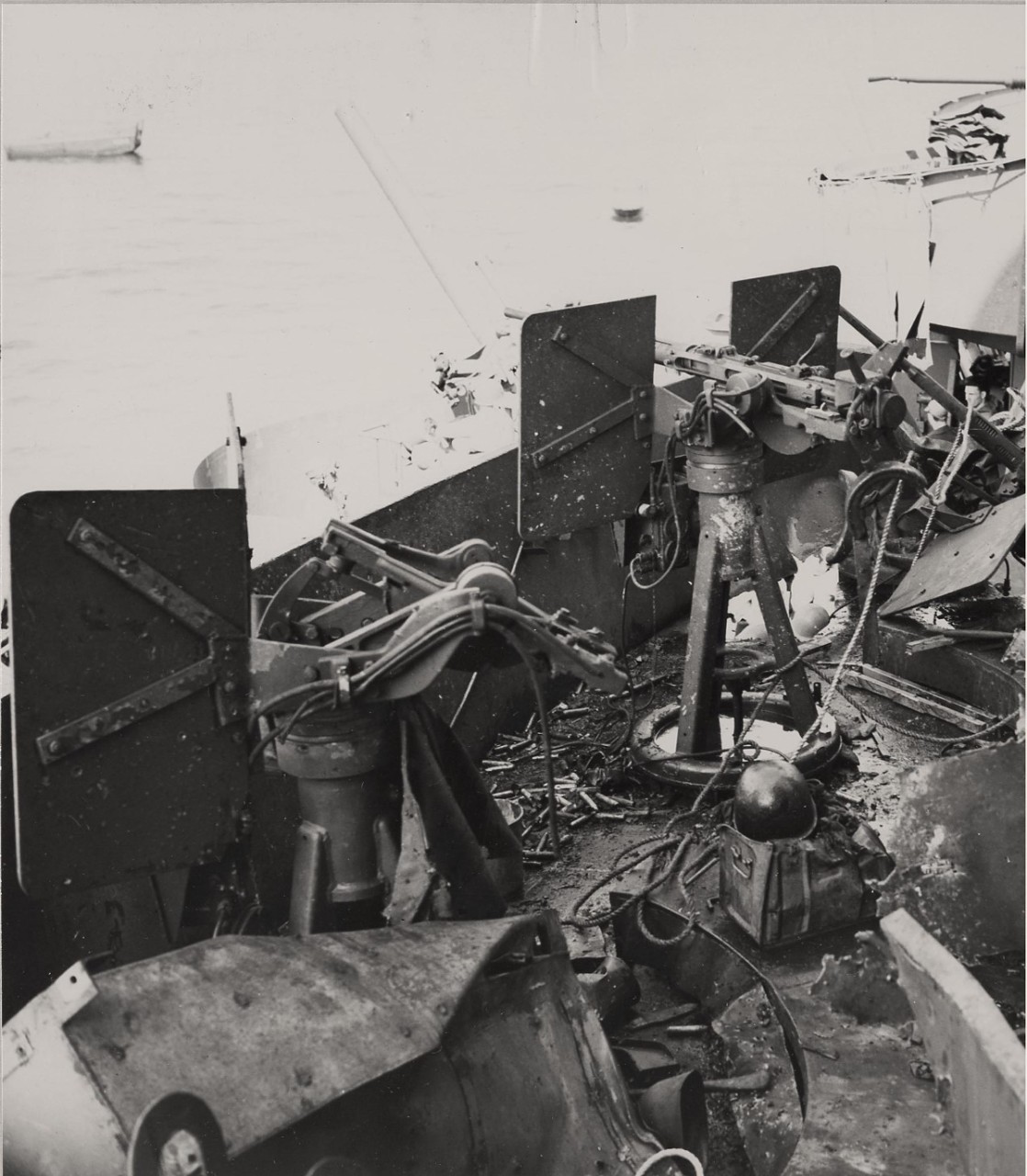
Photo of 20mm mounts on New Mexico’s (BB-40) starboard side looking aft. The second plane, a “Frank” crashed into the starboard 20mm mounts causing many casualties. Note the spent casings on the deck, evidence of the crew’s valiant efforts to fight off their attacker. (80-G-326648, NARA II College Park, Md.)
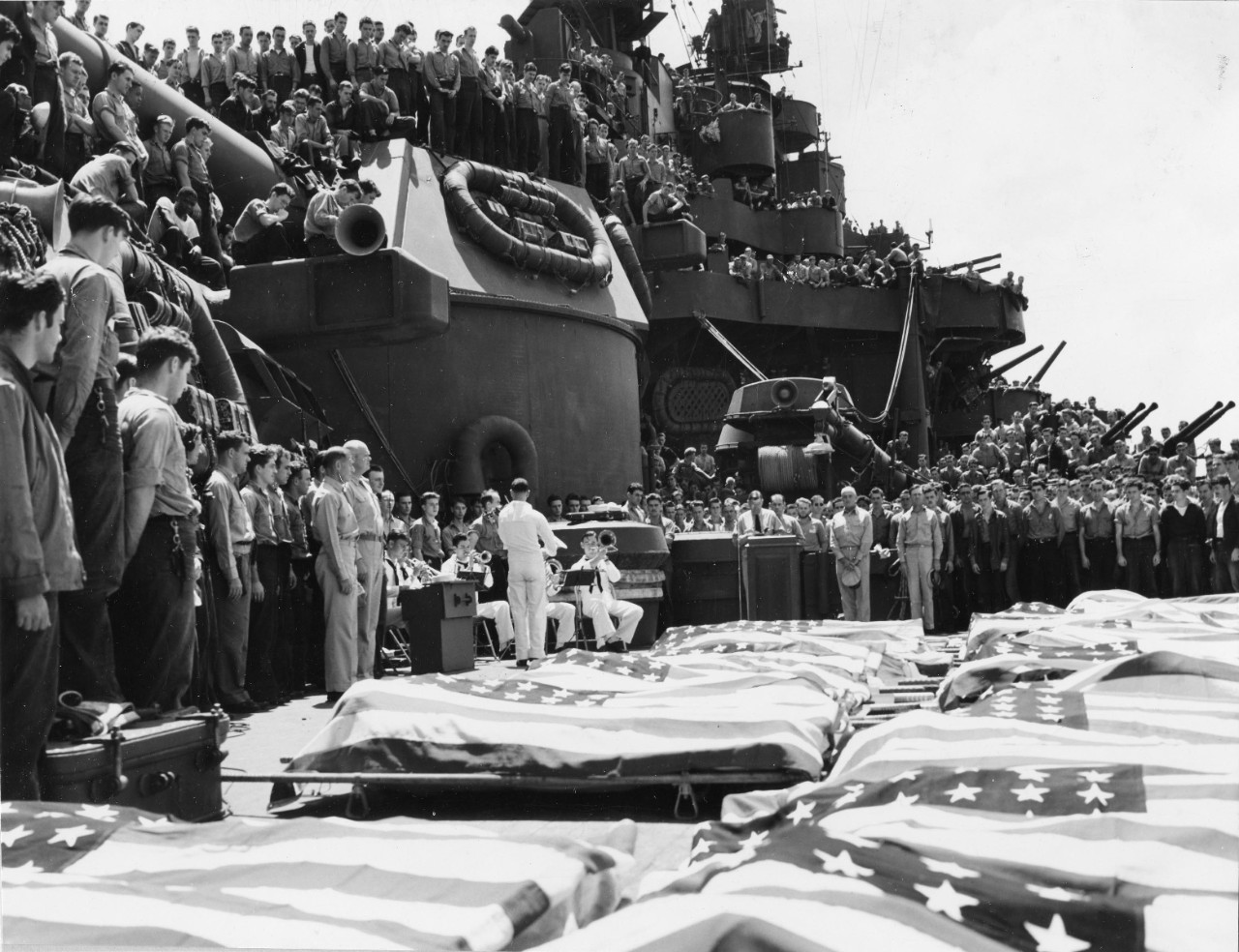
Chaplain Harold E. Buckley conducting services from podium on 13 May for crew killed in kamikaze attacks the previous evening. Admiral Raymond Spruance, Fifth Fleet commander, is at left of the bandstand alongside Lt. Cyrus R. Huie, USNR, ship’s band. To the immediate right of Buckley is New Mexico’s skipper, Capt. John M. Haines and his executive officer, Cmdr. Charles B. Beasley. (80-G-326656, NARA II, College Park, Md.)
Fifty-four Sailors and Marines, mainly those on A.A. guns, were killed and more than 100 wounded. Casualties came primarily from the kamikaze crash, but also from the strafing fire of both planes and friendly fire that came belatedly as the planes were well into their dives. As was the case with countless other ships facing similar attacks off Okinawa, “identifying the dead was extremely difficult as well as an unpleasant task in that many bodies were extensively mutilated.”[3] The bodies were placed in shrouds that night and identification process took until sunrise due to several more air defense interruptions. With the colors moved to half-mast, shipmates said their final farewells in a funeral service on board New Mexico attended by Admiral Raymond Spruance at 1050 on 13 May. By 1124, hostilities resumed with reports of multiple enemy periscope sightings coming from nearby ships. All the dead were removed for burial by the U.S. Army, 27th Division Cemetery at Okinawa by the Graves Registration Service.
—Richard Hulver, Ph.D., NHHC History and Archives Division, May 2020
*****
New Mexico casualties from 12 May 1945
KIA/MIA—54 Total
Enlisted Navy—28
Enlisted Marines—23
Missing in Action Navy—3
Wounded—119 Total
Officers Navy—2
Enlisted Navy—99
Officers Marines—1
Enlisted Marines—17
Sailors and Marines Killed and Missing
Sailors |
Marines |
Adams, Carl Cooper S1c |
Anderson, Delmer Dale Pfc |
Beutler, Alma John S2c |
Andrus, Calvin Steele Pfc |
Boyd, Jessie Earl S1c |
Burrows, Willie Ernest Pfc |
Carpenetti, Anthony Edward GM2c |
Crafton, Robert Charles Pfc |
Carpenter, Max David S2c |
Daniel, Milton Darle Sgt. |
Cash, Norris S2c |
Douthitt, Edward Tennant Pfc |
Duganier, Armon Joe S2c |
Duncan, Charles Ammon Cpl |
Dukes Wallace GM2c |
Earson, Albert Claude Pfc |
Enders, John Nelson EM3c |
Kirk, James Joseph Jr. Pfc |
Fields, Lester Francis Coxswain |
Knezevich, Rudolph Elbert Pfc |
Figg, Everett Eugene BM2c |
Lasocki, Edward William Pfc |
Flickinger, Richard Leroy Jr. Coxswain |
Minahan, John Patrick Pfc |
Franklin, Robert Theron S1c |
Owen, Ross Naxwell Pvt |
Gates, John Lenard EM3c |
Perry, William Carey 1st Sgt |
Graham, James Maurice S1c |
Petrovich, Samuel John Pfc |
Hart, Cletus Marshall S1c |
Rodewald, Charles Scott Pfc |
Hatcher, William Hudson S1c |
Rosenwicz, Alexander Charles Jr. Sgt |
Johnson, Oden Dana S1c |
Sealock, Warren Harding Ass’t Cook |
Key, John Lowis GM3c |
Senseman, Calvin Vercil Pfc |
Kimball, Orville Eugene S1c |
Smit, David Gordon Pfc |
Modesitt, Kenneth Wayne S1c |
Walton, Paul Thomas Sr. Pfc |
Moorefield, Alva James GM1c |
Wiseman, Reggie Neal Pfc |
Novak, Raymond Coxswain |
Zuniga, Leandro Pfc |
Palsma, Allen Wilbur S2c |
|
Rouceux, Walter Louis RM1c |
|
Schuler, Henry Edwin RM2c |
|
Teefy, Joseph Frince S2c |
|
Waters, Hiram Beverly PhM3c |
|
|
|
MIA |
|
Burhans, James S1c |
|
Felan, Adam Alfaro S2c |
|
Gordon, William Alva S1c |
|
[1] New Mexico, “Report of Okinawa Jima Operations,” V-6. Available at Fold3.com in War Diaries.
[2] “Special Action Report covering A.A. Action by the USS New Mexico (BB 40) on 12 May 1945,” 1 June 1945, 2. Available on Fold3.com in WWII War Diaries.
[3] New Mexico, “Report of Okinawa Jima Operations,” VII-2. Available at Fold3.com in War Diaries.


